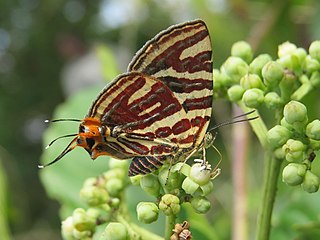
Dodona durga, the common Punch, is a small but striking butterfly found in the Indomalayan realm that belongs to the Punches and Judies, that is, the family Riodinidae.

Sabatinca incongruella is a species of moth of the family Micropterigidae. It is endemic to New Zealand and is found only in the northern parts of the South Island. It is a day flying moth and is on the wing from mid January until late February. The larvae of this species feed on liverworts and the adult moths feed on the spores of fern species in the genus Pneumatopteris. This species can be confused with S. chalcophanes as it is very similar in appearance.

Cigaritis lohita, the long-banded silverline, is a species of lycaenid or blue butterfly.
Antaeotricha mundella is a moth in the family Depressariidae. It was described by Francis Walker in 1864. It is found in Amazonas, Brazil.
Promenesta solella is a moth in the family Depressariidae. It was described by Francis Walker in 1864. It is found in Amazonas, Brazil.
Imma auxobathra is a moth in the family Immidae. It was described by Edward Meyrick in 1906. It is found on Borneo and in Nepal.
Imma chasmatica is a moth in the family Immidae. It was described by Edward Meyrick in 1906. It is found in the Indian states of Sikkim and Assam.
Imma megalyntis is a moth in the family Immidae. It was described by Edward Meyrick in 1906. It is found on Borneo.
Imma nephallactis is a moth in the family Immidae. It was described by Edward Meyrick in 1906. It is found in Venezuela.
Imma nephelastra is a moth in the family Immidae. It was described by Edward Meyrick in 1906. It is found on Borneo.
Imma strepsizona is a moth in the family Immidae. It was described by Edward Meyrick in 1906. It is found on Sulawesi.
Imma thyriditis is a moth in the family Immidae. It was described by Edward Meyrick in 1906. It is found on the Solomon Islands.
Imma lyrifera is a moth in the family Immidae. It was described by Edward Meyrick in 1910. It is found on New Guinea and Australia, where it has been recorded from Queensland.
Imma autodoxa is a moth in the family Immidae. It was described by Edward Meyrick in 1886. It is found on Fiji.
Imma halonitis is a moth in the family Immidae. It was described by Edward Meyrick in 1920. It is found in Chennai, India.
Imma alienella is a moth in the family Immidae. It was described by Francis Walker in 1864. It is found on Borneo.
Imma inaptalis is a moth in the family Immidae. It was described by Francis Walker in 1866. It is found on Borneo.
Imma pardalina is a moth in the family Immidae. It was described by Francis Walker in 1863. It is found on Borneo and in Malaysia (Selangor) and Singapore.
Imma tetrope is a moth in the family Immidae. It was described by Alexey Diakonoff in 1978. It is found in Nepal.

Tingena plagiatella is a species of moth in the family Oecophoridae. It is endemic to New Zealand and has been observed in both the North and South Islands. This species inhabits light native bush or scrubland. Adults of this species are on the wing from November to January.



